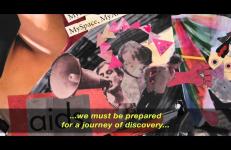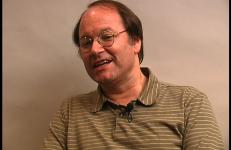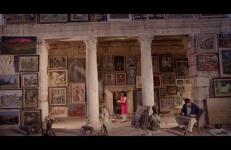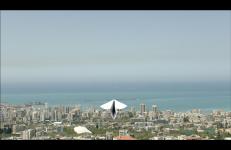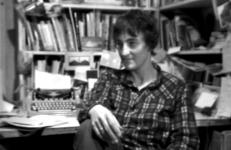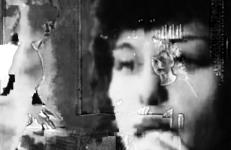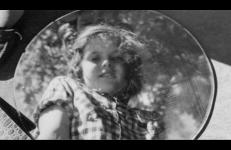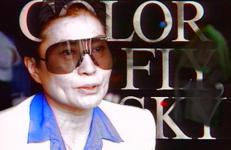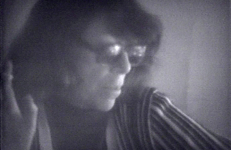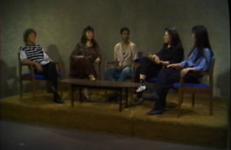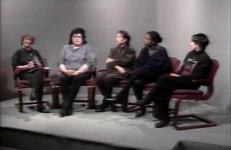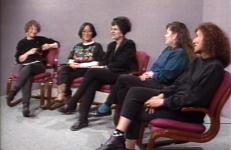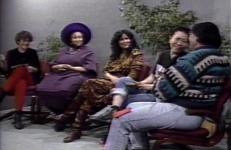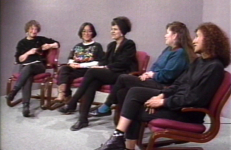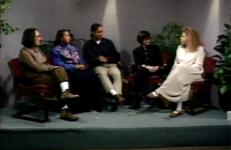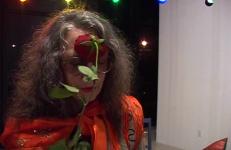Welcome to The History of the Future: A Franklin Furnace View of Performance Art. This disc set is based upon a live event that took place at the Abrons Art Center in New York City on April 27, 2007. Within this box set, you'll find performances from that event as well as historical videos that capture the thrills and chills of performance art during the last 30 years.
Art History
Set in East Berlin in 1977, this short experimental documentary interviews the Dadaist artist Hannah Höch as she reflects upon her experiences living and working during in 1920s Berlin. Höch compares the sociopolitical landscape of Berlin in the 1970s to its romanticised past of the Wiemar Era, while questioning the usefulness of nostalgia as an emotive tool.
In this interview, Brian Holmes, an influential art critic, activist and translator, discusses social forms of alienation, human ecologies of power, and the impact of technology on geopolitical social networks. Holmes reflects on his ongoing study of the ways in which the rhetoric of revolution has been institutionalized, as well as artists’ resistance to such cooption. For him, artists working in collectives have the potential to create a new artistic milieu that is not aligned with the dominant model of production. This argument is born out in his published collection of essays, Hieroglyphics of the Future (2003).
Museum collections of various kinds are the object of artist Dana Levy's ongoing, consistent study in the past decade.
"how looking at what has become the skeletons of photographs is a visual lecture on aesthetic pleasure or emotion. and how being, almost entirely denied of this pleasure, or having the pleasure merely suggested induces a viewer to ruminate on the act of viewing and that of wanting to view. and maybe it is evolution which causes this anxiety and art form."
In this short video, the Videofreex sit in on, and record part of, a lecture given by Jesse Ritter to undergraduate students at Princeton University in 1969. In the snippet of the lecture recorded, Ritter discusses Richard “Lord” Buckley, a 20th century American stage performer, recording artist, monologist, and hip poet/comic, whose contributions in the 1940s and 50s anticipated the aesthetic sensibilities of the Beat Generation.
The Baroness Elsa von Freytag-Loringhoven né Plotz, was an unsung member of the Dada Movement. A poet, artist, runaway, and all around public provocateur; she actively did not fit into her historical moment, and like most misfits, suffered for it. As with many women artists throughout history, her cultural legacy has been obscured and in some instances appropriated into the oeuvres of better known male peers.
Zaatari’s contribution to Lebanon’s Pavilion at the Venice Biennial 2013. This video offers a portrait of a public school and a tribute to those refusing illegal military orders.
Lucy Lippard (b. 1937) earned degrees from Smith College and New York University before beginning her career as an art critic in 1962, when she began contributing to publications such as Art International and, later, Artforum. In 1966, she organized an exhibition entitled “Eccentric Abstraction” at the Fischbach Gallery in New York City. “Eccentric Abstraction” set the standard for what would later be regarded as postminimalism, process, or antiform art.
Lossless #2 is a mesmerizing assemblage of compressed digital images of Maya Deren and Alexander Hammid’s 1943 masterpiece Meshes of the Afternoon. Baron and Goodwin play heavily with Teiji Ito’s 1959 soundtrack, making the film’s lyrical ambience feel more astonishing than ever before. --Neil Karassik
Lossless #2 is a mesmerizing assemblage of compressed digital images of Maya Deren and Alexander Hammid’s 1943 masterpiece Meshes of the Afternoon. Baron and Goodwin play heavily with Teiji Ito’s 1959 soundtrack, making the film’s lyrical ambience feel more astonishing than ever before. --Neil Karassik
This 12-minute video by Tom Palazzolo and Chicago writer Jack Helbig tells the story of the recently discovered Chicago street photographer Vivian Maier. Though she was unknown in her lifetime, her extensive body of work is rewriting the history of post-World War II American street photography. The video, told from the point of view of Maier herself, recounts her life and work, from her childhood in France to her move to NYC in 1951 and subsequent relocation to Chicago, where the majority of her work was done.
Performance artist/sculptor Ana Mendieta used the raw materials of nature: water, mud, fire, rock, and grass. The consciousness of her politics and the poetics of her expression fill her work with an emotionally charged vision that is powerfully conveyed in this posthumous video profile. Drawing upon the raw spiritual power of Afro-Cuban religion, Mendieta used her art as a ritualistic and symbolic activity to celebrate the forces of life and the continuum of change.
Performance artist/sculptor Ana Mendieta used the raw materials of nature: water, mud, fire, rock, and grass. The consciousness of her politics and the poetics of her expression fill her work with an emotionally charged vision that is powerfully conveyed in this posthumous video profile. Drawing upon the raw spiritual power of Afro-Cuban religion, Mendieta used her art as a ritualistic and symbolic activity to celebrate the forces of life and the continuum of change.
Lars Movin presents a video portrait of artists who have radically disrupted our conception of art since the 1960s. A large part of the video was made in Venice in 1990, when many of the original Fluxus artists met to hold a large exhibition in connection with the Biennale. The tape includes interviews with most of the leading Fluxus artists, documentation of their works, and clips from videos and films made during the 30 years of this ungovernable art form.
Joan Mitchell (1925-1992) was a "second generation" abstract expressionist painter and printmaker. She was an essential member of the American Abstract expressionist movement, and one of the few female painters to gain critical and public acclaim in the era.
The second in a series of cross-cultural symposia organized by Lucy Lippard, the four artists interviewed here—Jolene Rickard, Robbie McCauley, Judy Baca, and May Sun—discuss their work and its cultural contexts. Moderated by Lucy Lippard.
The third in a series of cross-cultural symposia organized by Lucy Lippard, the four artists interviewed here—Jean Lamar, Hung Liu, Lorna Simpson, and Kathy Vargas—discuss their work and its cultural contexts. Moderated by Lucy Lippard.
The fourth in a series of cross-cultural symposia organized by Lucy Lippard, the four artists interviewed hereÑJapanese-American painter and political activist Betty Kano, conceptual and performance artist Lorraine O'Grady, Hopi weaver Ramona Sakiestewa, and Chicana narrative and installation artist Celia Alvarez Muñoz–discuss their work and its cultural contexts.
The fifth in a series of cross-cultural symposia organized by Lucy Lippard, the four artists interviewed here–Tejana tableaux artist Santa Barranza, Taiwanese video and interactive installation artist Shu Lea Cheang, African-American sculptor and installation artist Joyce Scott, Native-American photographer Hulleah Tsinhnahjinnie–discuss their work and its cultural contexts. Moderated by Lucy Lippard.
The sixth in a series of cross-cultural symposia organized by Lucy Lippard, the four artists interviewed here–gay activist and self portrait artist Lyle Ashton Harris, Chicano photographer and tourist Robert Buitron, Cherokee writer, curator, and video creator Rayna Green, photography critic and professor at University of California-Irvine Catherine Lord, and Chinese-American video artist Valerie Soe–discuss the role of photography and creation of culture. Moderated by Lucy Lippard.
The seventh in a series of cross-cultural symposia organized by Lucy Lippard, the four artists interviewed here–visual anthropologist Wendi Starr-Brown, Hapa video and performance artist Kip Fulbeck, Japanese-American artist Dorothy Imagire, Chicana mixed-media artist Yolanda López–address the role of mixed-race identity in their work. Moderated by Corissa Schweitz Gold.
Linda M. Montano: 14 Years of Living Art is a video catalog of the artist’s exhibition, performance and workshop in Montreal in 2003. Produced in the context of a retrospective exhibition at the Liane and Danny Taran Gallery, the video presents a close view of Montano’s signture art/life counseling performance, interviews with participants, and views of the artworks in situ. It also documents Montano’s performance pedagogy during her all-night sleepover workshop which was collaboratively hosted by La Centrale and Rad’a.
In My Dinner With Weegee Donigan Cumming weaves together two life stories. The central figure, a man in his seventies named Marty, remembers his experiences in New York as a young Catholic labour organizer and peace activist, his friendships with David Dellinger, the Berrigan brothers, Bayard Rustin, Weegee, and James Agee. This mixture of first-hand knowledge and gossip brightens Marty’s dark passage—he is old, sick, depressed, and alcoholic.
Adapted, quite loosely, from interviews with the composer Karlheinz Stockhausen in the late 60s and early 70s.
Note: This title is intended by the artist to be viewed in High Definition. While DVD format is available to enable accessibility, VDB recommends presentation on Blu-ray or HD digital file.





